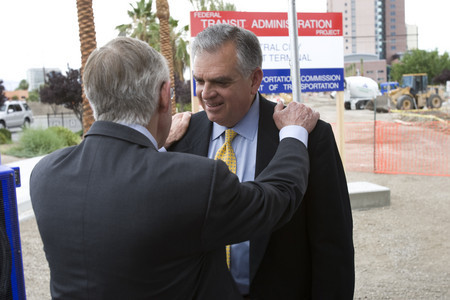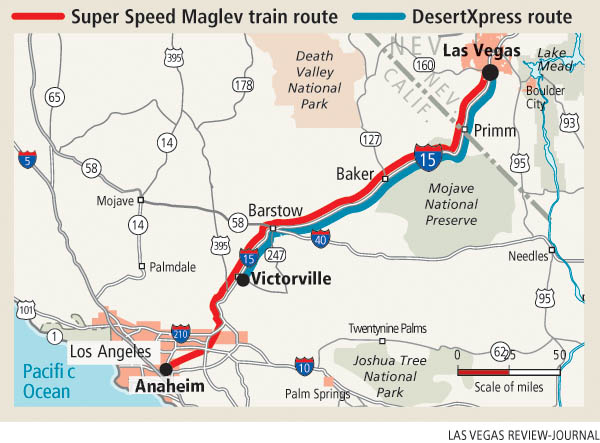Maglev rail project no longer attracts
Sen. Harry Reid on Thursday all but pronounced the death of a magnetic levitation train project proposed to connect Las Vegas to Southern California.
"Maglev is going nowhere," said Reid, D-Nev. It was an idea whose time he hoped had come, "but it hasn't, and it won't."
Reid proposed the $45 million that was allocated to the California-Nevada Super Speed train project in the 2008 federal transportation bill be spent elsewhere. Reid did not say how the money would be used, but said there were plenty of other transportation projects that the funding could support.
Reid does support the privately funded DesertXpress project, proposed to connect Las Vegas to Victorville, Calif.
For the past 30 years, Reid said he has backed the maglev concept. But on Thursday, he appeared fed up with the maglev project, which he said would cost $40 billion.
"I have personally arranged the appropriation of millions and millions of dollars, and it has gone to pay salaries and studies," he said.
But what seemed incredible to Reid was the proposal by maglev officials to build the first part of the train from Las Vegas to Primm. Extending the line to Anaheim, Calif., would come later.
"Think about that. Vegas to Primm," Reid said.
DesertXpress leaders say construction on their steel-wheel train can start as soon as 2010, with test trains up and running by 2013. It would open for service in 2014. Trains would travel at 150 mph and connect passengers from Victorville to Las Vegas in 84 minutes for $50 a fare.
DesertXpress would cost about $4 billion, which would come from private investment and federal loans. Officials hope to take advantage of the proximity, about 50 miles, between Victorville and Palmdale, Calif., where California transportation officials plan to create a hub for a high-speed rail system between Los Angeles and San Francisco.
Officials with the maglev project, a private and public partnership, say they can start construction as soon as 2011, with completion in 2016. The maglev would travel at 300 mph and connect passengers from Anaheim to Las Vegas in 87 minutes at a cost of $55 a fare.
Officials say it would cost $12.1 billion, which would come from public and private matching funds.
Reid's endorsement of the DesertXpress came at a news conference Thursday with U.S. Secretary of Transportation Ray LaHood, who announced that the California high-speed rail corridor had been extended to include Las Vegas.
By designating Las Vegas as part of the California high-speed rail corridor, the federal government is endorsing the idea of putting a fast-moving train between Las Vegas and Southern California. There are 10 high-speed rail corridors in the nation that have been endorsed by the Federal Railroad Administration, including the California corridor.
High-speed rail projects within a corridor can apply for federal stimulus money and take advantage of a streamlined application process for federal funding or loans.
The designation could help either of the competing rail projects.
DesertXpress officials said they will not seek funding from the federal stimulus package but will apply for federal loans.
Despite Reid's derision, maglev officials think their project still has a chance.
"We heard the senator's comment and hope he would reconsider," said Neil Cummings, president of American Magline Group, the private component of the public-private partnership behind the maglev.
Cummings said that if the maglev project does not get the $45 million from the 2008 transportation bill, "it would inhibit our effort to move ahead and complete our EIS (environmental impact statement)."
An environmental impact statement is needed before construction on any federally funded transportation project moves forward. The process can take years to complete.
DesertXpress officials are in the midst of the environmental impact statement for their project.
Maglev project officials plan to take advantage of the designation as part of the high-speed corridor by applying for the $8 billion of federal funding set aside for high-speed rail projects in the American Recovery and Reinvestment Act, Cummings said.
The application process starts next week. A decision on which projects will get the money will be made by the end of the year.
Richann Bender, executive director of the California-Nevada Super Speed Train Commission, said in a statement, "Now it's time for a transparent and fact-based discussion about which system best meets the needs of the people of Southern California and Nevada."
Contact reporter Francis McCabe at fmccabe@reviewjournal.com or 702-387-2904.


















